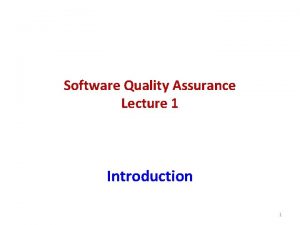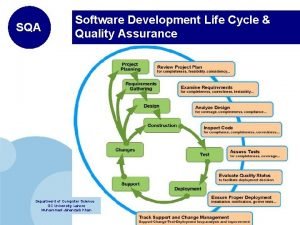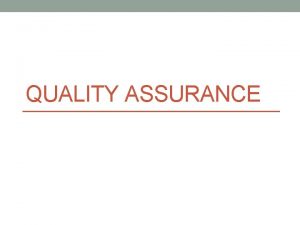Introduction to Group Work 1 Quality Assurance Programmes







- Slides: 7

Introduction to Group Work 1 Quality Assurance Programmes Group C (Singapore, Philippines, Viet Nam, Korea) Emerging Disease Surveillance and Response (ESR) WHO Western Pacific Regional Office (WPRO) 1

Current WHO EQAP for detection of influenza A by PCR Strengths? • Laboratories find how they are doing relative to an international standard • Inclusion of inactivated virus considered an improvement • Provides confidence in ability to detect H 5, as this is not routinely tested for in samples coming into NIC • Additional care in following SOP has tended to overcome any problems detected from a lower EQAP Weaknesses? • Permits for importation can be time consuming and lead to delays Emerging Disease Surveillance and Response (ESR) WHO Western Pacific Regional Office (WPRO) 2

Current WHO EQAP for detection of influenza A by PCR Areas to improve? *Proficiency testing of sub-national labs – a need to include in an EQAP – how can this be managed practically? Can sub-national labs be included? *NICs to be certified by international certification *Clear instructions on how to send back monitoring chips *Question raised regarding whether the test should be harder – laboratories will not routinely achieve 100% but *Quantities of virus to vary more markedly *Moving towards compulsory NIC participation as a tool for them to reach a certain standard. Emerging Disease Surveillance and Response (ESR) WHO Western Pacific Regional Office (WPRO) 3

Other programmes: do you participate in the following? List the labs participating in the following programmes Free: – – CDC: Philippines – contacted by CDC, yet to participate Korea – no other EQAP RCPA, EQA Institute Pasteur – both used in Pasteur Institute, Viet Nam Strengths and Weaknesses of the above programmes Uncertainty as to how many different programmes to participate in? Emerging Disease Surveillance and Response (ESR) WHO Western Pacific Regional Office (WPRO) 4

Scope of EQAP: Needs to be expanded? ü Virus culture – Philippines, Singapore, Korea, Vietnam HCM, Vietnam Hanoi, ü Antivirals (phenotypic or genotypic) – Philippines, Korea, HCM to set up ü Sequencing – Philippines (not extensive as yet), Singapore, Korea, Vietnam HCM & Hanoi ü Serology – HI testing in Korea, Philippine, Singapore ü Others – microneutralization (Korea, Philippines, Hanoi) • Issues relating to setting up additional NIC EQAP ? - very difficult to send virus for culture. Possibly expensive. Importation issues - sequencing EQAP easier? Emerging Disease Surveillance and Response (ESR) WHO Western Pacific Regional Office (WPRO) 5

Preferred features of EQAP? • Number of samples - 10 -12 generally considered to be OK • Type of samples - for current EQAP, would dilution series help to identify threshold of detection in each particular NIC - inclusion of virus considered a big bonus (makes it more interesting! Extraction required) - would a mock clinical specimen be useful? Treat as ‘real’ samples and treat as such. - would be interesting to have a type A that was not easily subtyped…… But how to ensure it is not a virus without pandemic potential - turnaround time – should EQAP be treated with a ‘clinical turnaround’ – sample processed as if it were an unknown sample entering the laboratory - inclusion of co-infections? - different diagnostic methods used by different NICs – difficulty in setting an absolute threshold of detection but a titration might be useful Emerging Disease Surveillance and Response (ESR) WHO Western Pacific Regional Office (WPRO) 6

Preferred features of EQAP? • Frequency - generally happy with 2 x per year - suggestion of one panel to focus on different avian influenza, perhaps including a dilution to check for threshold of sensitivity • Time to reporting - the one month wait – sometimes the lab ‘forgot’ they had done the test by the time the report is received. - should timing of performing the PCR and submitting the results be recorded? This would monitor that EQAP was treated rapidly (would test ability to recognize and respond to novel virus) • Format of reports - received by email. Generally happy with format. Emerging Disease Surveillance and Response (ESR) WHO Western Pacific Regional Office (WPRO) 7













